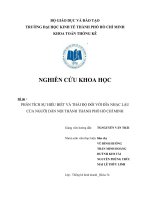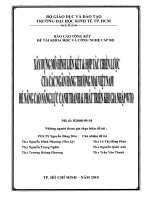Sự hiểu biết và liên minh hợp tác chiến lược doc
Bạn đang xem bản rút gọn của tài liệu. Xem và tải ngay bản đầy đủ của tài liệu tại đây (482.92 KB, 23 trang )
Chapter 9
Understanding Alliances and
Cooperative Strategies
2
OBJECTIVES
Describe why strategic alliances are
important strategy vehicles
1
Describe the motivations behind alliances and
show how they’ve changed over time
2
Explain the various forms and structures of
strategic alliances
3
Explain alliances as both business level and ‑
corporate level strategy vehicles‑
4
Understand the characteristics of alliances in
stable and dynamic competitive contexts
5
Summarize the criteria for successful
alliances
6
3
AN ALLIANCE THAT FITS LIKE A GLOVE
gloves
Magla
Mr. Clean
Expand into
European markets
Differentiate its
product
P&G
Extend the
brand
4
THE WHITE WAVE-DEAN ALLIANCE
35% ownership
Dean
Foods
$15 million
Leverage over retailers
(e.g., slotting fees)
White
Wave
5
BENEFITS OF STRATEGIC ALLIANCES
•
Share investments and rewards
•
Reduce risk
•
Reduce uncertainty
•
Focus resources on what each
partner does best
•
Foster economics of scale and scope
Companies which participate most
actively in alliances outperform the
least active firms by 5 to 7 percent
Why?
6
ALLIANCES ARE NOT STRATEGIES IN THEMSELVES
An alliance is one vehicle
for realizing a strategy
Arenas
Differentiators
Economic
Logic
Staging
Vehicles
7
THE USE OF ALLIANCES AS STRATEGIC VEHICLE HAS BALLOONED
1980 1995
2%
16%
Alliances as percent of revenues
As of 2007,
large MNCs have over 20%
of their total assets tied
up in alliances
8
ALLIANCES OFFER BENEFITS, CONTRACTS CANNOT
Joint Investment
Increase returns by
encouraging firms to make
investments that they’d be
otherwise unwilling to make
(e.g., Wal-Mart supplier
becomes willing to invest in
new equipment)
Complementary Resources
Opportunity to create a
stock of resources that is
unavailable to competitors.
This may create a shared
advantage (e.g., Nestlé and
Coke combined resources
to offer canned tea and
coffee products
Knowledge sharing
Consistent information-
sharing routines enhances
learning (e.g., John Deere
exchanges key employees
with alliance partner Hitachi)
Informal management
Alliances may make it
more cost effective to
manage an activity than
arm’s-length transactions
or acquisitions
9
ALLIANCES MAY BUILD COMPETITIVE ADVANTAGE
Alliances may serve to build a competitive advantage if
Rivals cannot ascertain what generates the returns because of causal
ambiguity surrounding the alliance
Rivals can figure out what generates the returns but cannot quickly
replicate the resources owing to time decompression diseconomies
Rivals cannot imitate practices or investments because they are missing
complementary resources (they have not made the previous investments
that make subsequent investments economically viable) and because the
current costs associated with prior investments are now prohibitive
Rivals cannot find a partner with the necessary complementary strategic
resources
Rivals cannot access potential partners’ resources because they are
indivisible
Rivals cannot replicate a distinctive and socially complex institutional
environment that has the necessary formal and informal controls that
make managing alliances possible
10
MOTIVATION FOR ALLIANCES HAS CHANGED OVER TIME
Source: Adapted from J. Harbison and P. Pekar, Smart Alliances: A Practical Guide to Repeatable Success (San Francisco: Jossey-
Bass, 1998)
Product performance
focus
1970s
Produce with latest
technology
Market beyond national
borders
Sell product stressing
performance
Position focus
1980s
Build industry stature
Consolidate position
Gain economies of scale
and scope
Learning and
capabilities focus
Post 2000
Ensure constant stream
of new prospects with
advancing technology
Proactively maximize
delivered value
Optimize total cost by pro-
duct/customer segment
Gain advantage in res-
ponse to changing condi-
tions and responsibilities
11
THE WAL-MART – CIFRA ALLIANCE
Cifra
Knowledge of Wal-Mart’s business model
Knowledge of the
market in Mexico
Wal-Mart
12
ALLIANCES CAN TAKE MANY FORMS
Examples of cooperative arrangements in the continuum of organizational forms
Permanent
Keiretsu in Japan or
Chaebols in South
Korea
Caltrex, which was
jointly owned by
Chevron and
Texaco prior to their
merger.
Long-term
Outsourcing Many technology
standards consortia
Examples include
technology collaborations
like the PowerPC chip
between Motorola, IBM,
and Apple
Anheuser-Busch’s
cross ownership with
Kirin in Japan and
Modelo in Mexico
Stand-alone joint
ventures like Dow-
Corning.
Transactional
Purchase agreements
that are renewable
annually or every
several years
Agreements to
distribute products
or services
Cross-licensing like that
between Disney and Pixar
or R&D partnerships like
Millennium Pharma-
ceuticals and some of its
smaller partners
Simple purchase order
for commodities, some-
times called a spot
transaction
Short-term agreements on functions like
advertising or manufacturing to achieve
efficiencies – for example, contract brewing of
Miller Beer by Anheuser Busch
Level of
Commitment
No Linkages Beyond
Transaction
Information
Sharing
Asset, Resource, and
Capability Sharing
Cross-Equity
(partners take
ownership in one
party or each other)
Shared Equity
Source: Adapted from J. Harbison and P. Pekar, Smart Alliances: A Practical Guide to Repeatable Success (San
Francisco: Jossey-Bass, 1998
Non-Equity Alliances Equity Alliances
13
MULTI-PARTY ALLIANCES
2 party alliances Multiparty alliances
Example: SEMATECH, a consortium
of semiconductor manufacturers
14
WHO MIGHT BECOME AN ALLIANCE PARTNER?
New
entrants
Suppliers
Rivals
Customers
Substitutes
Any other
organization could
become an alliance
partner
Firms
Complementors
15
2 TYPES OF BUSINESS STRATEGY ALLIANCES
Examples
Timkin and
suppliers
Mondavi and
top foreign wine
producers
Vertical
Partner with one or more suppliers or
customers. Typically done to create more
value for the end customer and to lower total
production costs along the value chain
1
Partner with a rival or potential competitor to
gain access to multiple segments of the
industry and reduce risk, improve efficiency,
or foster learning
Horizontal2
16
EXAMPLES OF NETWORKS OF BUSINESS ALLIANCES
Coopetition is essentially the notion that companies are com-
plementors when they make markets and competitors when
they divide markets. This relationship is called a value net
Timken Co. is getting its cus-
tomers to think of them as more
than simply a bearings supplier by
employing sophisticated bundling
processes to combine basic
bearings with additional
components in order to provide
companies with exactly what they
need. As a result, their bundled
products are a source of reliability
and cost reduction for their
customers like Caterpillar. Also,
Timken’s acquisitions don’t create
value simply due to added product
lines, but instead due to the greater
value added by a more complex
and tailored bundle
Your
Company
Suppliers
Most often ignored
source of value creation
Only recently are firms
recognizing that
working
with suppliers is as
important as listening to
the customer….
17
RISKS ARISING FROM ALLIANCES
Poor contract management
Failure to make complementary
resources available
Misrepresentation of resources
and capabilities
Being held hostage through
specific investments
Misappropriation of resources
and capabilities
Misunderstanding a partner’s
strategic intent
18
RISKS ARISING FROM ALLIANCES
?
Redhook Ale
Was Redhook Ale held captive by
its alliance with Anheuser Busch?
19
FIVE LEVERS FOR INCREASING THE PROBABILITY OF ALLIANCE SUCCESS
Understand the determinants of trust
Be able to manage knowledge and learning
Understand alliance evolution
Know how to measure alliance performance
Create a dedicated alliance function
20
BENEFITS OF TRUST
Knowledge
Sharing
Routines
Dedicated
Asset
Investments
Interfirm
Trust
•
TRUST is one party’s confidence that the other party in the exchange relationship will fulfill its promises and
commitments and will not exploit its vulnerabilities
•
Trust and alliances are a conundrum from a classical economics perspective – assumption of opportunism means
firms must choose market or hierarchy, make or buy, not an alliance
’
BUT
Trust lowers transaction costs
•
Search costs
•
Contracting costs
•
Monitoring costs
•
Enforcement costs
AND
•
Increases knowledge sharing
•
Increases investments in dedicated
assets
Trust and Competitive Advantage
21
FOUR KEY FACTORS AFFECT TRUST
Initial
conditions
Negotiation
process
Reciprocal
experiences
Outside
behavior
Trust
22
COMPONENTS OF A DEDICATED ALLIANCE FUNCTION
Alliance
business case
Partner
assessment
and selection
Alliance
negotiation and
governance
Alliance
management
Assessment
and termination
•
Value-chain
analysis form
•
Needs-analysis
checklist
•
Manufacturing-
vs partnering
analysis
•
Partner screening
form
•
Technology and
patent-domain
maps
•
Cultural-fit
evaluation form
•
Due-diligence
team
•
Negotiations
matrix
•
Needs-vs wants
checklist
•
Alliance-contract
template
•
Alliance-structure
guidelines
•
Alliance-metrics
framework
•
Problem-tracking
template
•
Trust-building
work sheet
•
Alliance-contact
list
•
Alliance-
communication
infrastructure
•
Relationship-
evaluation form
•
Yearly status
report
•
Termination
checklist
•
Termination-
planning work
sheet
23
•
Strategic fit?
•
Resource fit?
•
Cultural fit
•
Structural fit?
•
Other questions?
Why?
WHEN DO PARTNERS FIT?
Firms must address a number of
issues to determine fit …









